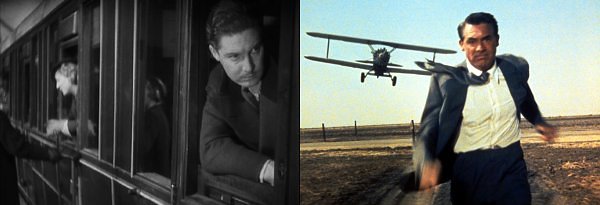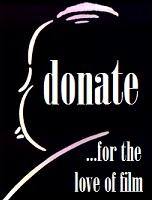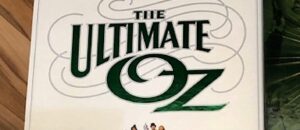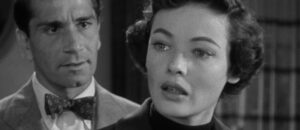[Editor’s Note: For this entry in the Hitchcock Blogathon, we’re joined by John Carvill, writer and editor of the UK-based arts and pop culture web site Oomska.co.uk. John has graciously contributed an article that he describes as “an unscientific analysis of the Blu-ray editions of Alfred Hitchcock’s ‘The 39 Steps’ & ‘North by Northwest’.” -JZ]
Let’s get our terms defined right away. This isn’t going to be an in-depth technical assessment of the Blu-ray editions of these two canonical Hitchcock movies. Nor will it aspire to erudite cultural or artistic analysis. Instead, the intention is to persuade the reader merely to pause and question the conventional wisdom which holds ‘North by Northwest’ to be a vastly superior remake of Hitchcock’s earlier, cheaper and infinitely less starry version of the same story, ‘The 39 Steps’.
Of course, the conventional argument is an easy one to make, and to defend. Hitchcock basically remade the same, quintessentially “Hitchcockian” story (in which an innocent man is sucked into a paranoid vortex, pursued by traitorous spies and wrong-headed authorities, and left reliant for survival on the caprices of an ambiguous female) almost a quarter of a century further into his illustrious career. He had bigger stars, bigger sets and bigger budgets. He had the opportunity to rectify any mistakes or shortcomings in the original film, and to indulge in any number of baroque enhancements to the later one. In the public imagination, ‘North by Northwest’ vies for the ultimate title of “best Hitchcock film” in a way that ‘The 39 Steps’, whatever its undoubted merits, can never hope to do.
If you wanted to keep the debate short, you might well decide just to slam-dunk it with that irrefutable two word clincher: Cary Grant. After all, who could quibble with the way in which Grant floats through the later film with a grace and élan that would be the envy of Muhammad Ali? Surely, no comparable argument could be mustered in defence of poor old Robert Donat in ‘The 39 Steps’? Well, we’ll return to that later; suffice to say that, yes, Cary Grant is Cary Grant and is, as such, unassailable – the quintessential Hitchcock leading man (James Steward notwithstanding). His wry elegance makes him as perfect a match as any actor has ever been for any role.
But there are two main problems with this line of thinking. Firstly is the fact that so powerful an argument for the later film’s superiority does Cary Grant make, that we being to wonder if the film is much more than simply a Cary Grant vehicle. What if we were to remove Grant from the picture? How much would Grant’s absence from the equation unbalance the result? Would we still think of ‘The 39 Steps’ as the poor relation? Of course, this is firmly within the realms of “What if?”. The second problem is less theoretical: Cary Grant is so effective in the role – or, to put it another way, so much does it seem that the role effectively is Cary Grant – that he threatens to overwhelm the film. Although there are worse things that can happen to a film (or to a lady) than being overwhelmed by Cary Grant, let’s at least allow that this can lead to a certain one-sidedness, even (dare we say it?) a degree of one-dimensionality.
And if Grant threatens to tip the scale too far in one direction, his leading lady is, in a number of ways, lamentably light. Now, as an actress, Eva Marie Saint is perfectly fine; but she’s no match for Grant, and was never destined to be anywhere near so luminescent a screen star. By and large, she makes a decent candidate for the designated “Hitchcock Blonde” role: She’s elegant, sophisticated, beautiful, classy, and certainly not devoid of comic talent. But she is simply not sexy, and there’s absolutely no getting away from that fact. She also generates no chemistry whatsoever with Grant, and the audience thus experiences no sense of emotional investment in the couple’s relationship.
Compare these factors to their analogues in the earlier film. The gap in star status between Donat and Madeleine Carroll wasn’t half as great. In fact, neither was (or is) in the first rank of marquee names – and, of course, there are names on the cast list of ‘The 39 Steps’ that have since acquired more lustre than either of the film’s two main stars. In any case, despite the size of Donat’s role, and the fact that he inhabits it just as convincingly as Grant does his, the earlier film never feels like a one man show, nor does it ever rely on Donat’s own public identity as a film actor, as ‘North by Northwest’ sometimes seems to do with Grant’s star persona, to the detriment of his character, and with consequent difficulties in suspension of audience disbelief.
Madeleine Carroll, a better and much more complex actress than Eva Marie Saint, brings plentiful nuance and subtlety to the role. She generates unmistakable screen chemistry with Donat right from the start. A lot could be written on how their relationship, with each other and with the audience, develops, deepens and evolves. More importantly perhaps is the plain fact that Madeleine Carroll is incredibly sexy, in an earthy yet glamorous way which far transcends the limited, Vogue cover-girl hauteur of Eva Marie Saint. Well, isn’t this all subjective? Maybe. But, come on, can Hitchcock’s Hollywood remake offer anything half as sexually reverberant as the sequence during which Robert Donat, handcuffed to Madeleine Carroll, offers to help remove her wet tights?
Both of these films could loosely be classed as “comedy thrillers,” with the emphasis shifting from the latter to the former as the story is remade. Not only is there less of the conventional thriller to ‘North by Northwest’, but the relationship between the two strands is much more complex and tangled in ‘The 39 Steps’. The later, gaudily colourful film often feels like an arch comedy, with occasional dramatic overtones. It comes across as almost camp in its stylization. The older black & white version is more evenly balanced between light and dark. For instance, in ‘The 39 Steps’, when the Sheriff briefly fools Hannay into thinking that he believes his innocence, the way his tone abruptly changes after the police arrive, and he asks them what kept them and whether they think he likes “playing for time with a murderer,” there’s nothing funny about that sequence at all. It could give you goosebumps. Seconds later, however, when the Sheriff assures Hannay that he’ll be in London soon enough and thus save himself “the expense of a trunk call,” the way the he clicks his fingers (as if to say, “Take him away”) is exquisite in its hilariousness.
Inasmuch as there is any degree of balance at all between comedy and drama in ‘North by Northwest’, the dramatic elements feel layered on top of, even discrete from, the more dominant comic tones, whereas any attempt to separate the comedy from the underlying sense of menace in the earlier film would be like trying to unmix a gin and tonic. The result is that ‘The 39 Steps’ alternates between feeling funny and suspenseful, while ‘North by Northwest’ just feels like a lark from beginning to end. This disparity becomes more pronounced with repeated viewings. As the viewer’s familiarity with these films increases over the years, there’s a tendency to feel that certain scenes and aspects of ‘North by Northwest’ seem more admirable than lastingly enjoyable. Contrastingly, ‘The 39 Steps’ is unalloyed enjoyment all the way through. Finally, let’s admit to the semi-sacrilegious assertion that ‘North by Northwest’, despite its many charms, does go on just a tiny little bit too long, whereas ‘The 39 Steps’ is wonderfully compact.
Meanwhile, Robert Donat’s performance is one of the great unsung masterpieces of cinematic history. If ‘North by Northwest’ could in no way be mistaken for the best Cary Grant film, ‘The 39 Steps’ is, unquestionably, the underrated Donat’s finest hour and a half. It’s Donat, not Hitchcock, who contributes most to the film’s phenomenally immersive nature, and the way in which the audience identifies with the protagonist on so many levels. Think, to cite just one obvious example, of how a lump forms in even the most cynical viewer’s throat, as he cheers along with Donat’s rabble-rousing speech at the political rally in Scotland; and how we revel in the realisation that we are emoting over something so contrived and nakedly artificial. Then, once again, marvel at the subtlety with which the comic and the sinister are intertwined.
And so, let us turn at last to the technology. Blu-ray is an odd format. Not only is it in a peculiar place, in terms of the history of entertainment media – hailed (or maybe condemned) by Bill Gates, among others, as “the last physical format” – but also in the peculiar disconnect between the end-user experience and the native abilities of the underlying technology. Put simply, the quality of the Blu-ray edition of a given film is much less dependent on the extra data that can be squeezed onto the disc, than it is a result of how much care has been taken with the transfer. Thus, it is entirely possible to find quite recent movies which are no better on Blu-ray than they were on DVD. Happily, the reverse is also true, with some of the most universally lauded Blu-ray transfers yet released being reissues of films that are decades old. (See ‘The Searchers’ for a prime example.)
Well, whatever your feelings towards the format in general, it has to be said that the Blu-ray transfer of ‘North by Northwest’ is truly wondrous, and right up there with the best. The ITV Studios Blu-ray edition of ‘The 39 Steps’ released in the UK, on the other hand, is merely very good indeed, and does not offer (to the layman’s eye, at least) much noticeable improvement over some of the better DVD editions of the film. [Ed.: A Criterion Collection edition of ‘The 39 Steps’ is scheduled for release on June 26th. Whether that disc will be any better the existing UK copy remains to be seen. -JZ]
In conclusion, let’s say that both of these Blu-rays represent compelling reasons to invest in new editions of classic films. As a triumph of technology, the more recent film wins, hands down. But in pure entertainment terms, the earlier film may just be able to lay claim to being the more perfectly formed cultural artifact. Well, that may just be my opinion. But, in the words of Mr Memory himself, I ask you, imploringly: Am I right, Sir?!
—
In association with the National Film Preservation Foundation, High-Def Digest is proud to join the 2012 Hitchcock Blogathon. During the week of May 14th to 18th, we will blog about topics related to the films and career of the legendary Sir Alfred Hitchcock. This year, the NFPF hopes to raise money to fund a new musical score and online streaming distribution for ‘The White Shadow’, an early silent film that young Mr. Hitchcock (then officially a writer and Assistant Director) used as a stepping stone to launch his own directorial career. To contribute, please visit the NFPF’s donations page.
For additional information, also see the NFPF web site page or the Self-Styled Siren, Ferdy on Films and This Island Rod blogs.







Tinky
I completely agree with you about the relative merits of “The 39 Steps.” In fact, to tell you the truth, I was unaware of the conventional wisdom of which you write. I’ve always prefered it to NBNW, partly because it’s a much warmer as well as darker film, and partly because of the cast: let’s not forget Godfrey Tearle and the amazing Peggy Ashcroft, who just about steals the picture. This was fun.
Gregory Sandoval
Great article! I’m a Hitchcock fan but had never seen NXNW until picking up the Blu-Ray. I expected to be engaged in it based on all I had read and, while the transfer is certainly an achievement, the film lacked substance and felt contrived in its showiness. I will certainly check out The 39 Steps.
ttringle
Oh man, while I can see that NXNW may suffer in comparison to some of Hitchcock’s earlier work, the movie is just a ton of fun.
Where else are you going to get Cary Grant going head to head with James Mason. And the score is just one of the best ever in films.
Martin Landau as a black hearted thug, count me in.
And Eve Marie Saint, man she was just unbelievably beautiful in that movie.
The Drunk Driving scene is one of my favorites, especially when he starts giving the Glen Cove police lip (Hey I used to live there).
Josh Zyber
Folks, the National Film Preservation Foundation is still falling way short of its donations goal. Please show them that High-Def Digest readers care about film preservation by donating to this worthy cause.
ttringle
North by Northwest has been one of my favorite films ever since my English teacher in Junior HS had us read lines from it in class.
I was lucky enough to actually get to read the Cary Grant part and at that point in my life hadn’t yet seen the film. Suffice to say I was hooked after reading the UN scene and have loved the film to this day.
I need to pick up the Blu-Ray in fact, just haven’t gotten to it yet. I love the movie but I really hate that so many blu-ray’s are still so prohibitively expensive.
Guess I’ll just have to bite the bullet.
EM
I’m another who finds North by Northwest overrated. Granted, it has some amazing elements (the cropduster scene is classic!), but I find the whole to be less than the sum of its parts. The 39 Steps doesn’t happen to be a favorite of mine either, but it is a much more consistent experience.